Assessment of Spatio-Temporal Land Use/Cover Change and Its Effect on Land Surface Temperature in Lahaul and Spiti, India
Abstract
:1. Introduction
2. Study Area
3. Data Base
4. Methodology
4.1. Computation of Land Use/Land Cover Change
4.2. Computation of NDSI and NDVI
- Normalized Difference Vegetation Index (NDVI) is computed by using Near-Infrared and RED Sensor [29].
4.3. Estimation of Land Surface Temperature (LST)
- Top of Atmosphere (TOA) Radiance: Thermal infrared digital number (DN) is converted into spectral radiance (L)
- Top of Atmosphere (TOA) Brightness Temperature: Spectral radiance is converted into top of atmosphere brightness temperature in Kelvin.
- Land Surface Emissivity (LSE) is derived with the help of NDVI value using the formula which is given by Sobrino and Raissouni [31].
- Finally, Kelvin is converted into degrees Celsius with the equation given below:
4.4. Mann–Kendall Test
4.5. Estimation of Sen’s Slope
4.6. Accuracy Assessment
| Classified Data | Dense Vegetation | Sparse Vegetation | Snow | Barren Land | Water Body | Total | Commission Error (%) | User Accuracy (%) |
|---|---|---|---|---|---|---|---|---|
| Dense Vegetation | 120 | 5 | 0 | 2 | 0 | 127 | 5.5 | 94.48 |
| Sparse Vegetation | 3 | 130 | 0 | 13 | 0 | 143 | 7.80 | 90.90 |
| Snow | 0 | 0 | 105 | 8 | 2 | 115 | 8.69 | 91.30 |
| Barren Land | 1 | 4 | 3 | 125 | 4 | 136 | 8.08 | 91.91 |
| Water Body | 0 | 0 | 6 | 8 | 110 | 124 | 11.29 | 88.70 |
| Total | 124 | 134 | 114 | 154 | 116 | 518 | - | - |
| Omission Error (%) | 3.22 | 2.98 | 7.89 | 12.40 | 8.25 | - | - | - |
| Producer Accuracy (%) | 96.77 | 97.01 | 92.10 | 81.16 | 94.82 | - | - | - |
| Classified Data | Dense Vegetation | Sparse Vegetation | Snow | Barren Land | Water Body | Total | Commission Error (%) | User Accuracy (%) |
|---|---|---|---|---|---|---|---|---|
| Dense Vegetation | 150 | 6 | 0 | 4 | 0 | 160 | 6.25 | 93.75 |
| Sparse Vegetation | 4 | 125 | 0 | 10 | 0 | 139 | 10.07 | 89.92 |
| Snow | 0 | 0 | 110 | 6 | 4 | 120 | 8.33 | 91.66 |
| Barren Land | 2 | 5 | 4 | 120 | 3 | 134 | 10.44 | 89.55 |
| Water Body | 0 | 0 | 8 | 5 | 125 | 138 | 9.42 | 90.57 |
| Total | 156 | 136 | 122 | 145 | 132 | 691 | - | - |
| Omission Error (%) | 3.84 | 8.08 | 9.83 | 17.24 | 5.30 | - | - | - |
| Producer Accuracy (%) | 96.15 | 91.91 | 90.16 | 82.75 | 94.69 | - | - | - |
| Classified Data | Dense Vegetation | Sparse Vegetation | Snow | Barren Land | Water Body | Total | Commission Error (%) | User Accuracy (%) |
|---|---|---|---|---|---|---|---|---|
| Dense Vegetation | 160 | 8 | 0 | 3 | 0 | 171 | 6.43 | 93.56 |
| Sparse Vegetation | 6 | 182 | 0 | 9 | 0 | 191 | 4.71 | 95.69 |
| Snow | 0 | 0 | 125 | 5 | 3 | 133 | 6.01 | 96.74 |
| Barren Land | 4 | 4 | 3 | 170 | 5 | 182 | 6.59 | 93.40 |
| Water Body | 0 | 0 | 3 | 5 | 112 | 120 | 6.66 | 93.33 |
| Total | 170 | 186 | 131 | 189 | 120 | 626 | - | - |
| Omission Error (%) | 5.8 | 2.15 | 4.58 | 10.05 | 6.66 | - | - | - |
| Producer Accuracy (%) | 94.11 | 97.84 | 95.41 | 89.94 | 93.33 | - | - | - |
5. Result and Discussion
5.1. States of Land Use/Land Cover
5.2. Land Use/Cover Change Detection
5.3. Land Use/Cover Change Analysis through Matrix Table
5.4. Land Use/Land Cover Change with Altitudinal Zones
5.5. Land Surface Temperature (LST) Change Analysis
5.6. Impact of LULC Change on LST
5.7. The Relationship of LST with NDSI and NDVI
6. Conclusions
Author Contributions
Funding
Data Availability Statement
Conflicts of Interest
References
- Oinam, S.S.; Rawat, Y.S.; Khoiyangbam, R.S.; Gajananda, K.; Kuniyal, J.C.; Vishvakarma, S.C.R. Land use and land cover changes in Jahlma watershed of the Lahaul valley, cold desert region of the northwestern Himalaya, India. J. Mt. Sci. 2005, 2, 129–136. [Google Scholar] [CrossRef]
- Rahaman, S.; Kumar, P.; Chen, R.; Meadows, M.E.; Singh, R.B. Remote Sensing Assessment of the Impact of Land Use and Land Cover Change on the Environment of Barddhaman District, West Bengal, India. Front. Environ. Sci. 2020, 8, 127. [Google Scholar] [CrossRef]
- Nawaz, R.; Shrestha, H.L. Urban expansion and its implications for food security in Nepal: A case study of Kathmandu Valley. Land Use Policy 2016, 50, 52–62. [Google Scholar]
- Adhikari, B.; Williams, F.; Lovett, J.C. Local benefits from community forests in the middle hills of Nepal. For. Policy Econ. 2007, 9, 464–478. [Google Scholar] [CrossRef]
- Mondal, P.; Zhang, Y. Spatiotemporal Analysis of Impact of Land Use Land Cover Change on Ecosystem Services. In Proceedings of the 4th Asian Conference on Geography, Guangzhou, China, 6–10 December 2018. [Google Scholar]
- Skilodimou, H.; Livaditis, G.; Bathrellos, G.; Verikiou-Papaspiridakou, E. Investigating the flooding events of the urban regions of Glyfada and Voula, Attica, Greece: A contribution to Urban Geomorphology. J. Geogr. Ann. 2003, 85, 197–204. [Google Scholar] [CrossRef]
- Gujree, I.; Wani, I.; Muslim, M.; Farooq, M.; Meraj, G. Evaluating the variability and trends in extreme climate events in the Kashmir Valley using PRECIS RCM simulations. Model. Earth Syst. Environ. 2017, 3, 1647–1662. [Google Scholar] [CrossRef]
- Arun Kumar, A.; Gaur, T.; Upgupta, S.; Ramesh, K.; Kumar, S. Land Cover/Land Use Change and Fragmentation in Uttarakhand, the Western Himalaya Based on GlobeLand30 Datasets. In Smart Technologies for Energy, Environment and Sustainable Development; Springer Nature Singapore Pte Ltd.: Singapore, 2019; ISBN 978-981-13-6147-0. [Google Scholar]
- Rather, I.A.; Dar, A.Q. Assessing the impact of land use and land cover dynamics on water quality of Dal Lake, NW Himalaya, India. Appl. Water Sci. 2020, 10, 219. [Google Scholar] [CrossRef]
- Hansen, M.C.; Potapov, P.V.; Moore, R.; Hancher, M.; Turubanova, S.A.; Tyukavina, A.; Thau, D.; Stehman, S.V.; Goetz, S.J.; Loveland, T.R.; et al. High-resolution global maps of 21st-century forest cover change. Science 2013, 342, 850–853. [Google Scholar] [CrossRef] [Green Version]
- Kala, C.P. Indigenous Uses, Population Density, and Conservation of Threatened Medicinal Plants in Protected Areas of the Indian Himalayas. Conserv. Biol. 2005, 19, 368–378. [Google Scholar] [CrossRef]
- Kumar, P.; Singh, R.B.; Sinha, R. Land use/land cover change analysis using remote sensing and GIS in the upper catchment of Alaknanda River, Garhwal Himalaya. J. Indian Soc. Remote Sens. 2013, 41, 45–55. [Google Scholar] [CrossRef]
- Singh, P.; Singh, R.B.; Joshi, P.K. Assessment and monitoring of land use/land cover change and fragmentation in the upper catchment of Yamuna river using remote sensing and GIS. Environ. Monit. Assess. 2009, 153, 409–417. [Google Scholar]
- Herold, M.; Mayaux, P.; Woodcock, C.E.; Baccini, A.; Schmullius, C. Some challenges in global land cover mapping: An assessment of agreement and accuracy in existing 1 km datasets. Remote Sens. Environ. 2008, 112, 2538–2556. [Google Scholar] [CrossRef]
- Bhat, S.A.; Meraj, G.; Yaseen, S.; Bhat, A.R.; Pandit, A.K. Assessing the impact of anthropogenic activities on spatiotemporal variation of water quality in Anchar Lake, Kashmir Himalayas. Int. J. Environ. Sci. 2013, 3, 1625–1640. [Google Scholar]
- John, J.; Bindu, G.; Srimuruganandam, B.; Wadhwa, A.; Rajan, P. Land use/land cover and land surface temperature analysis in Wayanad district, India, using satellite imagery. Ann. GIS 2020, 26, 343–360. [Google Scholar] [CrossRef] [Green Version]
- Pu, R.; Gong, P.; Michishita, R.; Sasagawa, T. Assessment of multiresolution and multi-sensor data for urban surface temperature retrieval. Remote Sens. Environ. 2006, 104, 211–225. [Google Scholar] [CrossRef]
- Khandelwal, S.; Goyal, R.; Kaul, N.; Mathew, A. Assessment of land surface temperature variation due to change in elevation of area surrounding Jaipur, India. Egypt. J. Remote Sens. Space Sci. 2018, 21, 87–94. [Google Scholar] [CrossRef]
- Guo, G.; Wu, Z.; Xiao, R.; Chen, Y.; Liu, X.; Zhang, X. Impacts of urban biophysical composition on land surface temperature in urban heat island clusters. Landsc. Urban Plan. 2015, 135, 1–10. [Google Scholar] [CrossRef]
- Asgarian, A.; Amiri, B.J.; Sakieh, Y. Assessing the effect of green cover spatial patterns on urban land surface temperature using landscape metrics approach. Urban Ecosyst. 2015, 18, 209–222. [Google Scholar] [CrossRef]
- Mondal, P.P.; Zhang, Y. Research Progress on Changes in Land Use and Land Cover in the Western Himalayas (India) and Effects on Ecosystem Services. Sustainability 2018, 10, 4504. [Google Scholar] [CrossRef] [Green Version]
- Bajpai, S.C. Lahaul-Spiti: A Forbidden Land in Himalayas; Indus Publishing Co.: New Delhi, India, 1987; Volume 5. [Google Scholar]
- Sharma, R.; Kala, C.P.; Kala, S. Changes in land use and land cover of Spiti Valley, Indian Trans-Himalaya: A case study from 1980 to 2018. Environ. Monit. Assess. 2020, 192, 462. [Google Scholar]
- Bisht, D.S.; Tiwari, P.C. Land use and land cover change detection of Spiti sub-watershed using remote sensing and GIS techniques. Environ. Earth Sci. 2017, 76, 392. [Google Scholar]
- Bora, S.; Sarma, K.P.; Saikia, U. Forest cover change in Himachal Pradesh and its impact on ecosystem services. Environ. Monit. Assess. 2015, 187, 331. [Google Scholar]
- Ram, R.; Yadav, R.B. Spatiotemporal land use/land cover dynamics in the cold desert area of Himachal Pradesh, India. J. Environ. Biol. 2015, 36, 389–394. [Google Scholar]
- Cao, L.; Li, P.; Zhang, L.; Chen, T. Remote Sensing Image-Based Analysis of The Relationship Between Urban Heat Island and Vegetation Fraction; The International Archives of the Photogrammetry, Remote Sensing and Spatial Information Sciences: Beijing, China, 2008. [Google Scholar]
- Sobrino, J.A.; Raissouni, N.; Li, Z.L. A comparative study of land surface emissivity retrieval from NOAA data. Remote Sens. Environ. 2001, 75, 256–266. [Google Scholar] [CrossRef]
- Gilbert, R.O. Statistical Methods for Environmental Pollution Monitoring; John Wiley & Sons: Hoboken, NJ, USA, 1987. [Google Scholar]
- Mann, H.B. Nonparametric tests against trend. Econometrica. J. Econom. Soc. 1945, 13, 245–259. [Google Scholar] [CrossRef]
- Kendall, K. Thin-film peeling-the elastic term. J. Phys. D Appl. Phys. 1975, 8, 1449. [Google Scholar] [CrossRef]
- Sen, P.K. Estimates of the regression coefficient based on Kendall’s tau. J. Am. Stat. Assoc. 1968, 63, 1379–1389. [Google Scholar] [CrossRef]
- Valovcin, F.R. Spectral Radiance of Snow and Clouds in the Near Infrared Spectral Region; AFGL-TR; United States Air Force: Washington, DC, USA, 1978. [Google Scholar]
- Valovcirh, F.R. Snowicloud Discrimination; AFGL-TR; United States Air Force: Washington, DC, USA, 1976. [Google Scholar]
- Jiang, Z.; Huete, A.R.; Chen, J.; Chen, Y.; Li, J.; Yan, G.; Zhang, X. Analysis of NDVI and scaled difference vegetation index retrievals of vegetation fraction. Remote Sens. Environ. 2006, 101, 366–378. [Google Scholar] [CrossRef]
- Lillesand, T.; Kiefer, R.W.; Chipman, J. Remote Sensing and Image Interpretation; John Wiley & Sons: New York, NY, USA, 2000; Volume 4, ISBN 978-1-118-34328-9. [Google Scholar]
- Kumar, P.; Husain, A.; Singh, R.B.; Kumar, M. Impact of land cover change on land surface temperature: A case study of Spiti Valley. J. Mt. Sci. 2018, 15, 1658–1670. [Google Scholar] [CrossRef]
- Dhillon, S.S. Changing Pattern in Agricultural Land Use in Mahasu District (Himachal Pradesh), 1951–1966. Ph.D. Thesis, Kurushetra University, Thanesar, India, 1973. [Google Scholar]
- Dhillon, S.S. Altitudinal Agro-climatic Zones and their Rhythm in Mahasu District (H.P.). Geogr. Rev. India 1975, 37, 300–304. [Google Scholar]
- Gao, J.; Shi, J.; Li, Z.; Zhou, Y. Effect of land use/land cover change on the surface temperature in Shenzhen, China. Urban Clim. 2020, 32, 100623. [Google Scholar]
- Wang, R.; Li, H.; Liu, H.; Zhu, A.X. Impacts of land use and land cover change on land surface temperature in the Yangtze River Delta, China. J. Geogr. Sci. 2020, 30, 1299–1310. [Google Scholar]
- Zhang, P.; Xia, J.; Liu, L. Impacts of land use and land cover change on surface temperature in the urbanizing region of Northeast China. J. Clean. Prod. 2019, 227, 569–578. [Google Scholar]
- Gao, J.; Liu, J.; Tian, Y.; Li, Z. Impacts of land use and land cover change on surface temperature in Beijing, China. Int. J. Remote Sens. 2020, 41, 5931–5949. [Google Scholar]
- Li, X.; Yin, H.; Wang, Y.; Zhang, S. Impact of land use and land cover change on land surface temperature in Yinchuan, China. Int. J. Appl. Earth Obs. Geoinf. 2019, 76, 150–158. [Google Scholar]

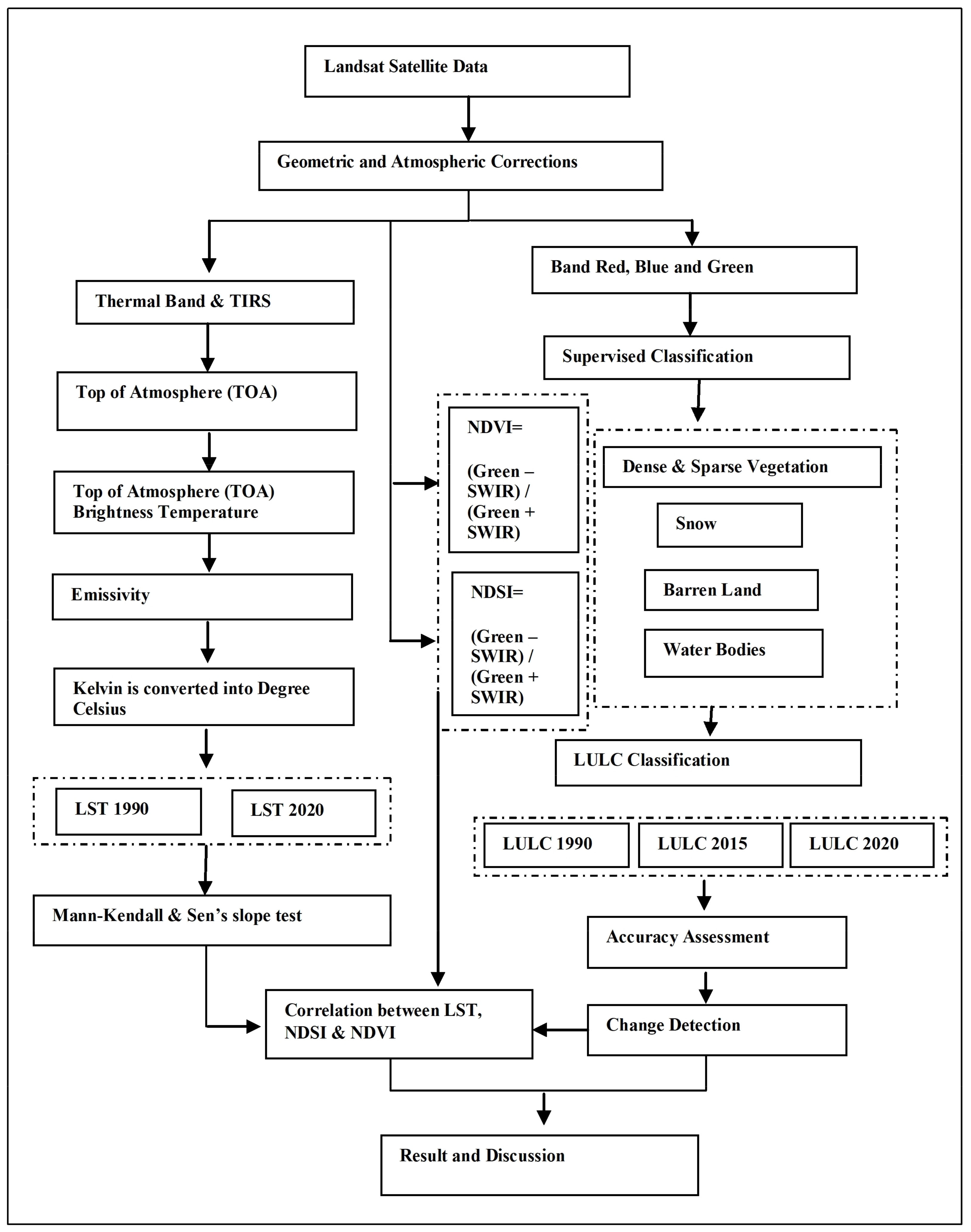
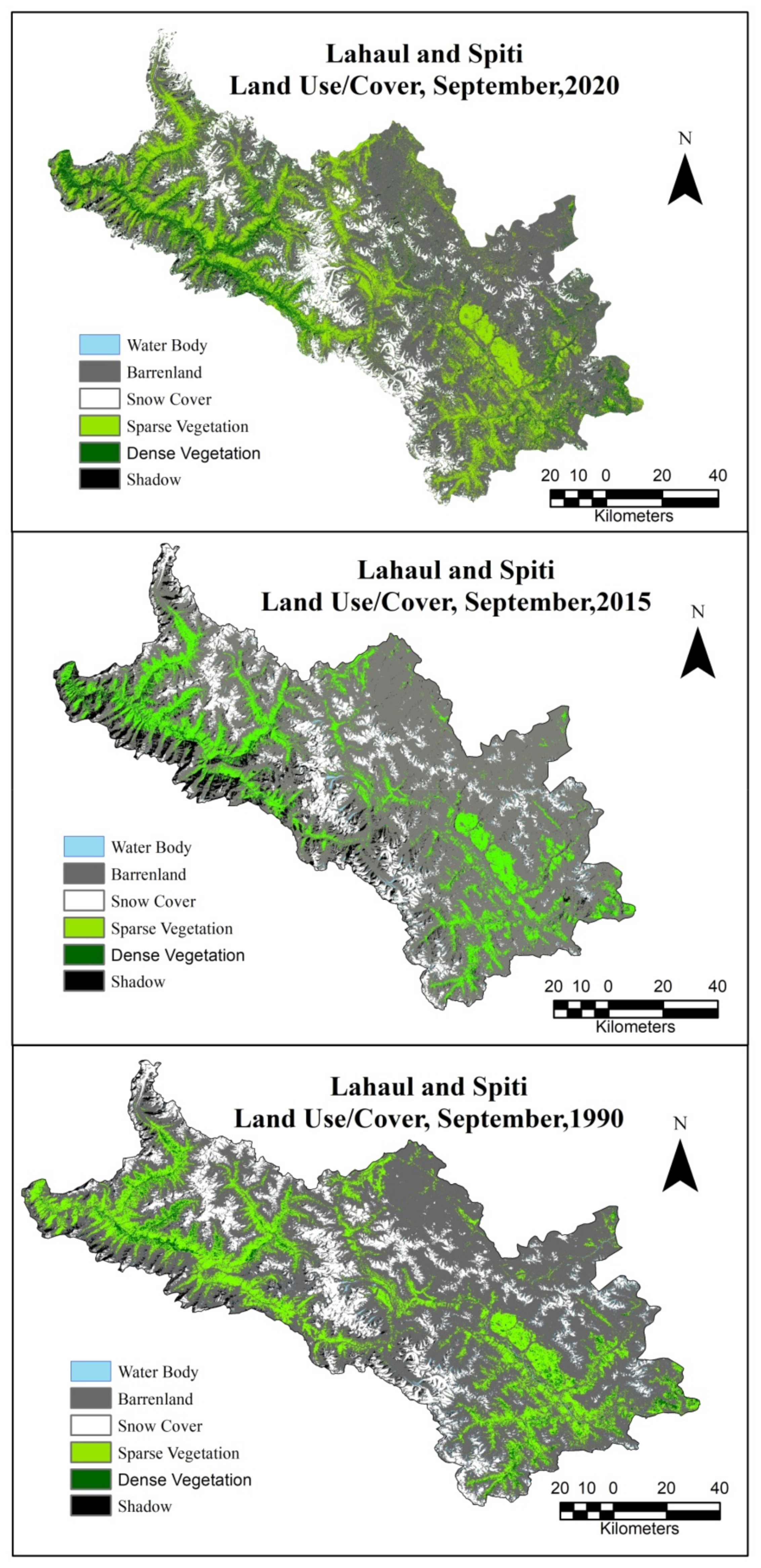
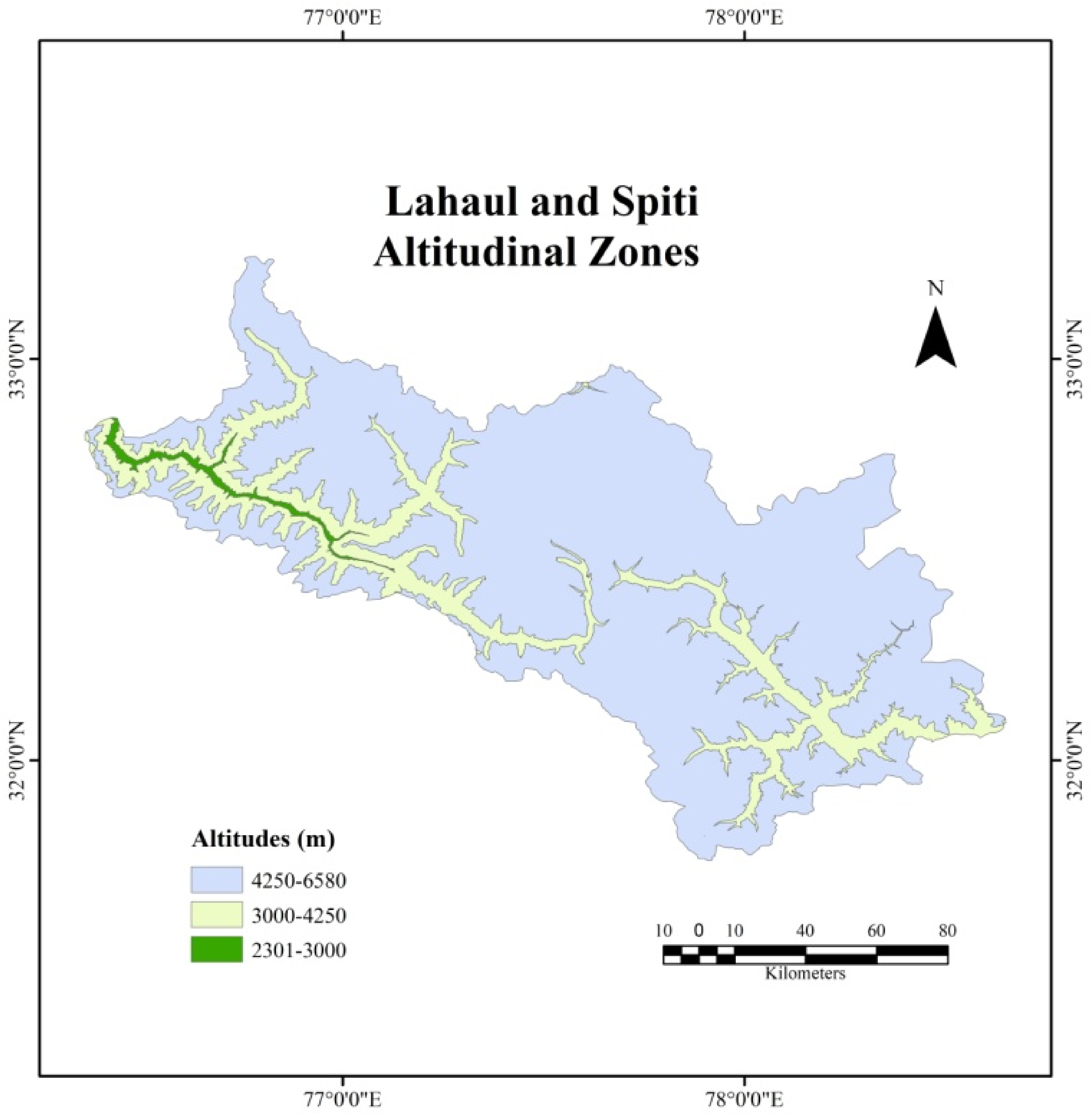
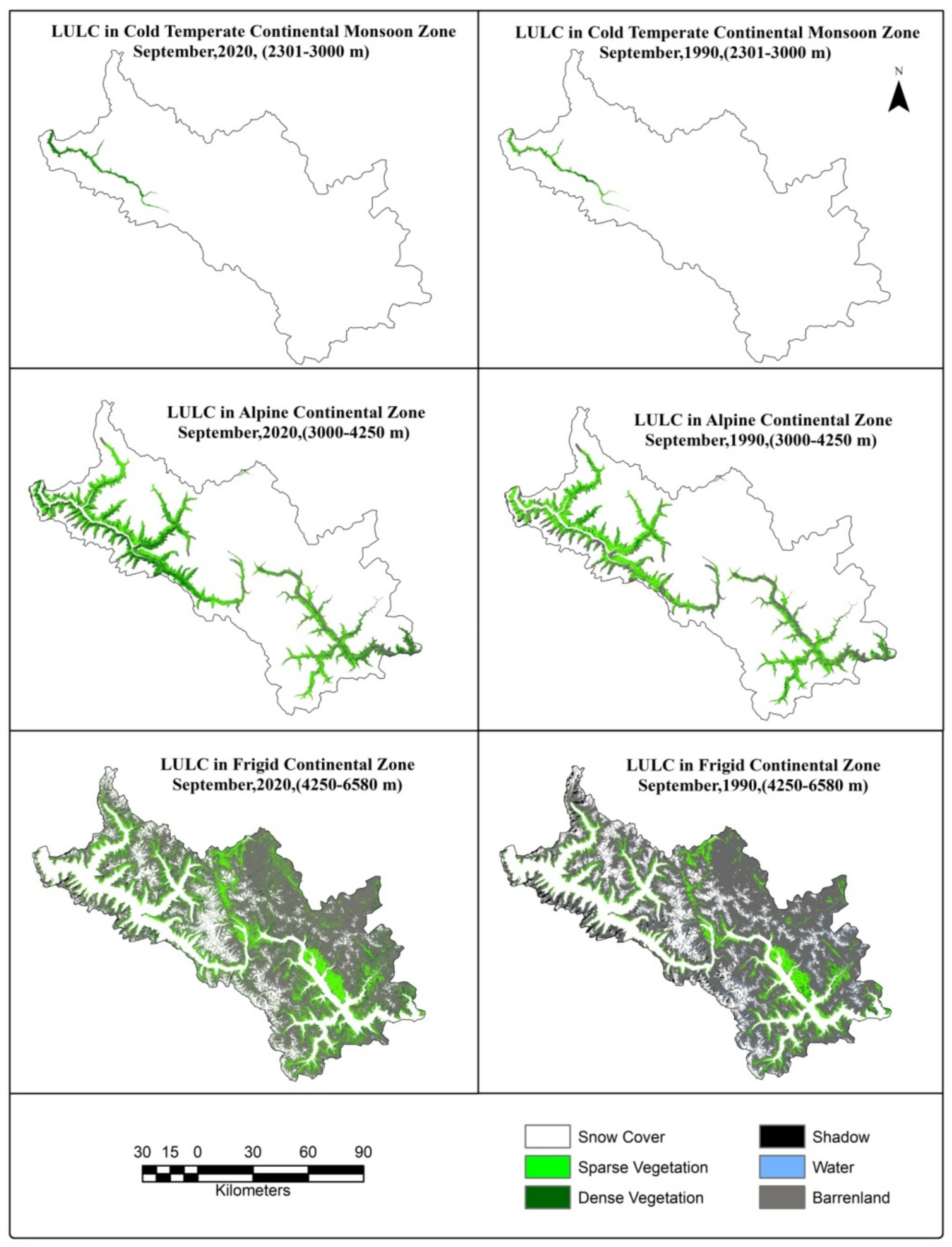

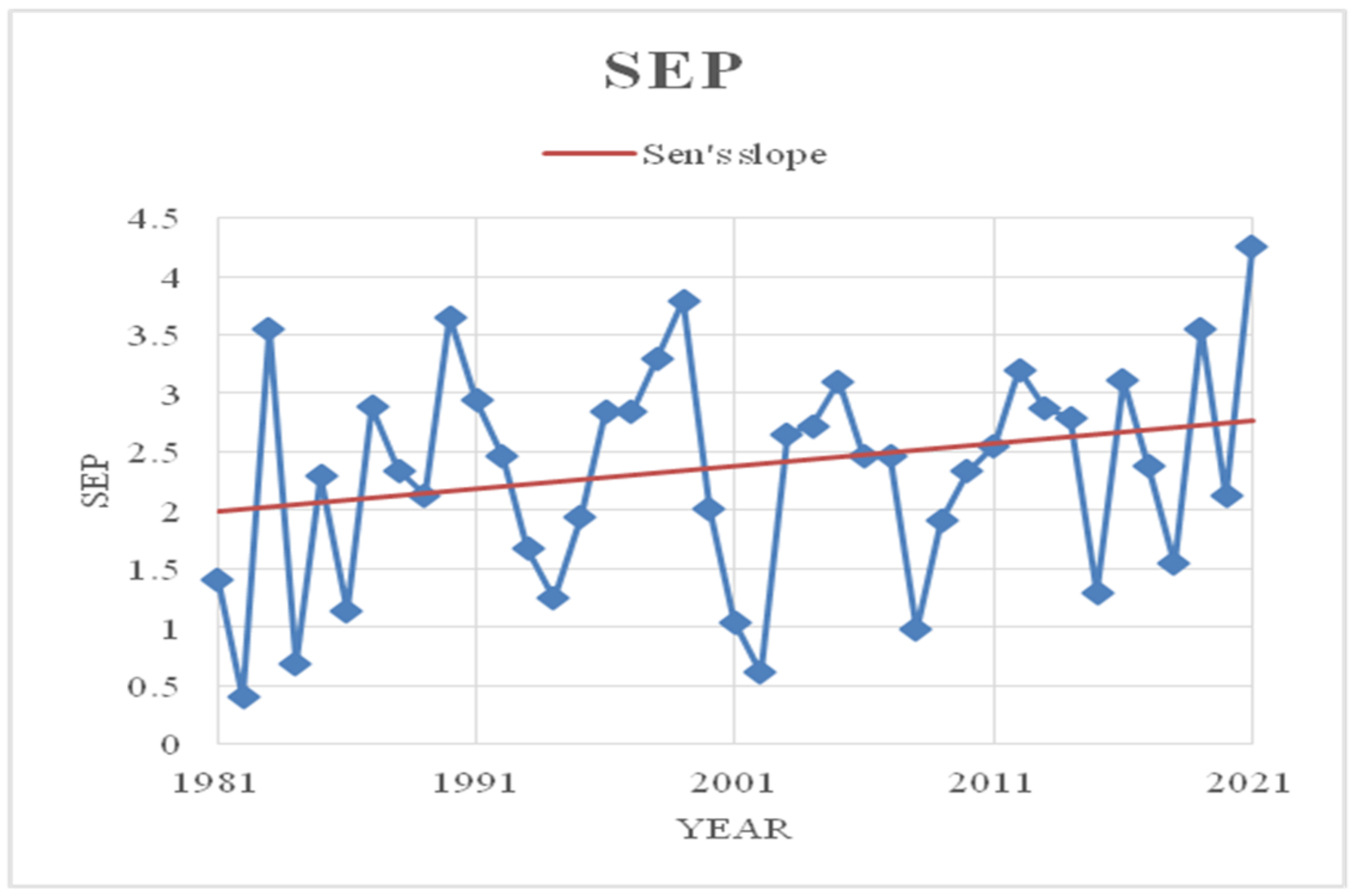

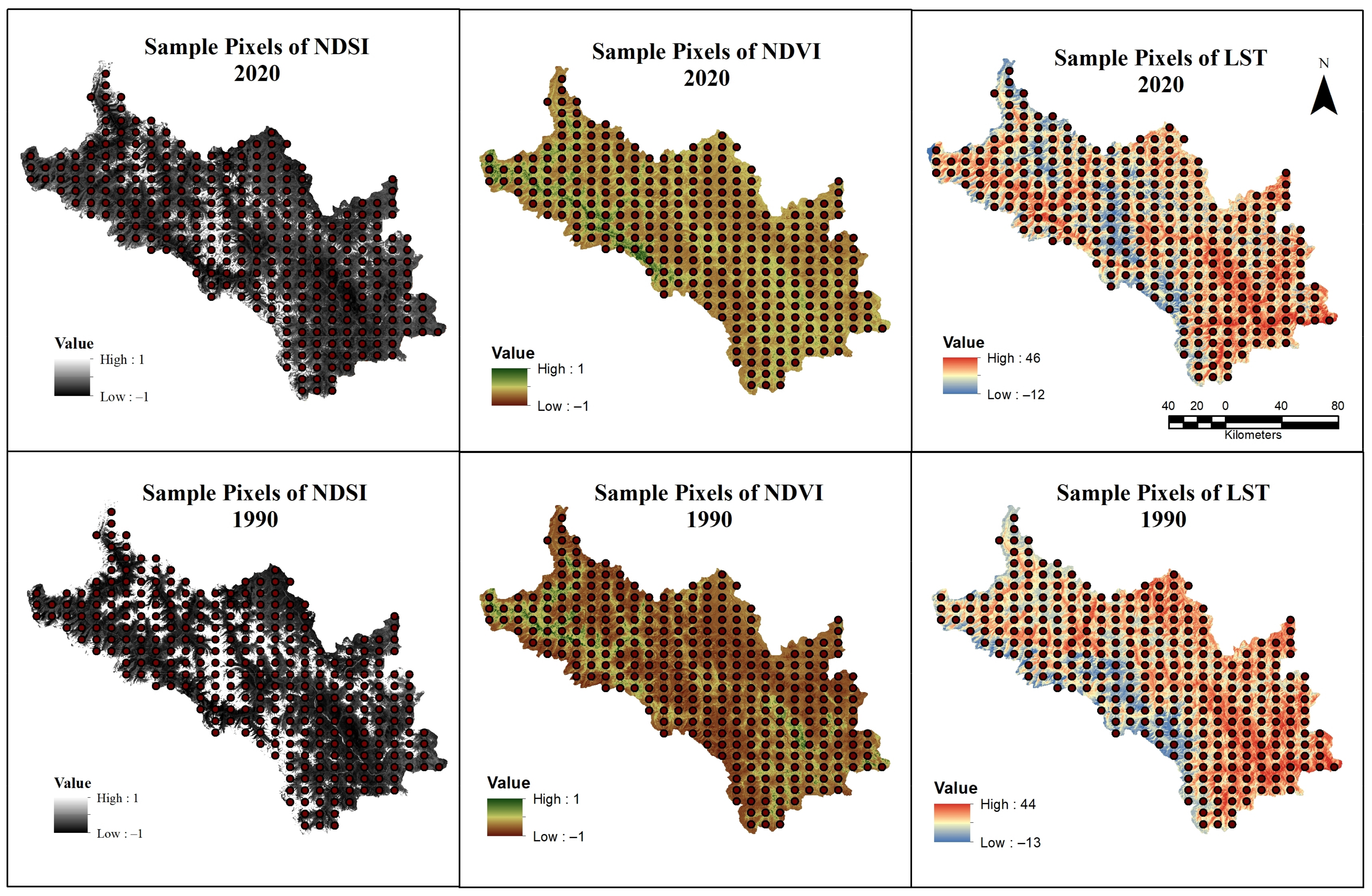
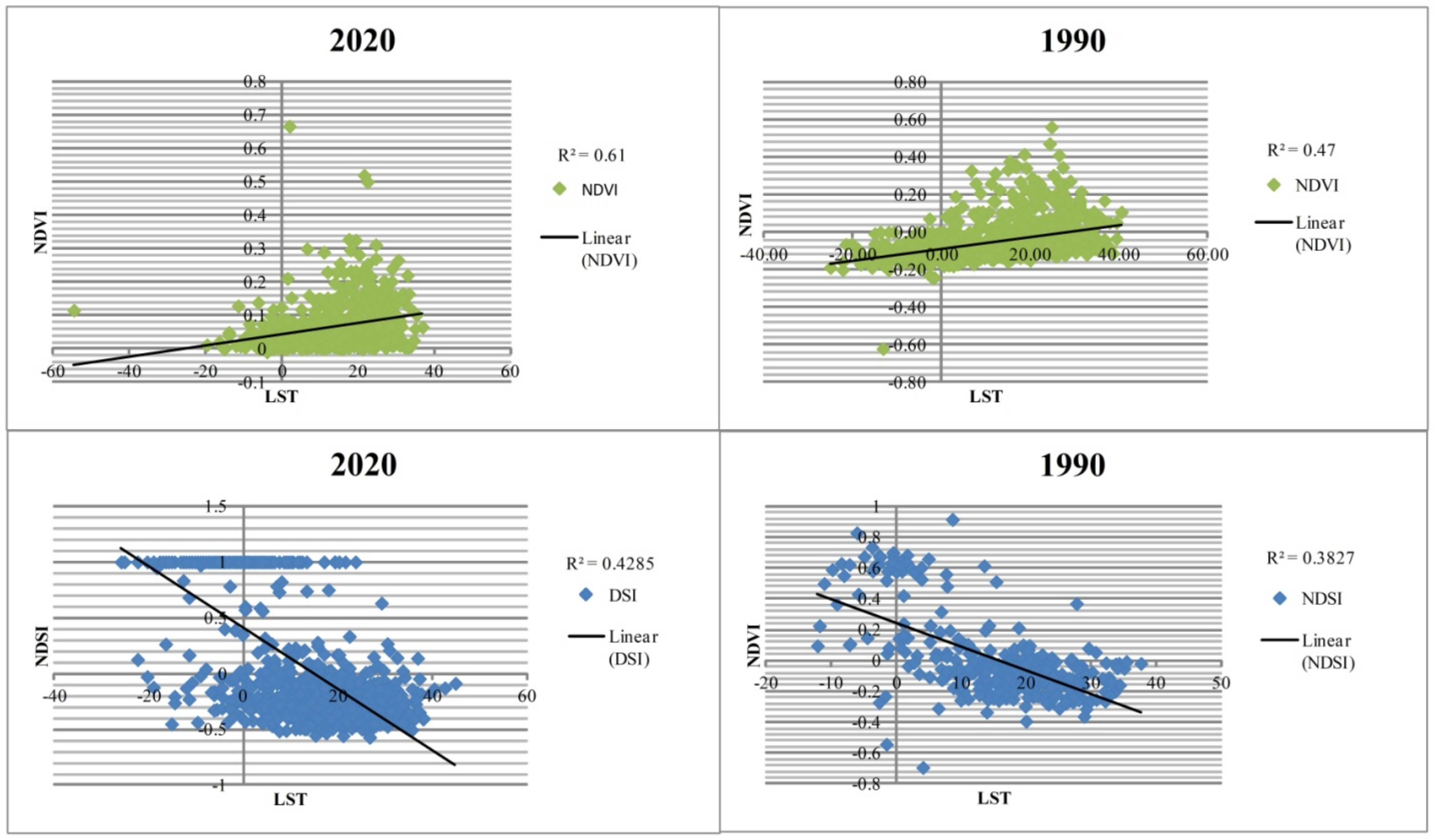
| Satellites | Raw | Path | Date of Acquisition | Scene Centre Time | Bands | Sensor | Resolution |
|---|---|---|---|---|---|---|---|
| Landsat 5 | 37, 38 | 147, 148 | 10 September 1990 | 04:38:03 | 4, 3, 2 | TM | 30 m |
| Landsat 5 | 37, 38 | 147, 148 | 10 September 1990 | 04:20:45 | 6 | Thermal | 120 m × 30 |
| Landsat 5 | 37, 38 | 147, 148 | 10 September 2010 | 04:38:03 | 4, 3, 2 | TM | 30 m |
| Landsat 8 | 37, 38 | 147, 148 | 5 September 2020 | 05:17:55 | 5, 4, 3 | OLI | 30 m |
| Landsat 8 | 37, 38 | 147, 148 | 5 September 2020 | 05:30:20 | 10, 11 | TIRS | 100 m × 30 |
| LULC | General Description |
|---|---|
| Sparse Vegetation | Small shrubs and natural grass |
| Dense Vegetation | Crops, apple orchards and trees |
| Snow | Area covered with snow |
| Barren Land | Bare exposed rocks |
| Water Body | River, stream, glacial lake, etc. |
| LULC | 1990 | 2015 | 2020 |
|---|---|---|---|
| Total Area | 1,384,506 | 1,384,506 | 1,384,506 |
| Barren Land | 844,244 | 834,544 | 714,150 |
| Sparse Vegetation | 234,784 | 242,861 | 279,228 |
| Snow Cover | 188,445 | 183,080 | 176,180 |
| Dense Vegetation | 33,864 | 35,682 | 123,666 |
| Water Body | 83,169 | 88,339 | 91,282 |
| LULC Types | 1990–2020 | |
|---|---|---|
| Area (ha.) | Area (in %) | |
| Barren Land | −130,094 | −15 |
| Sparse Vegetation | +44,444 | 19 |
| Snow Cover | −12,265 | −7 |
| Dense Vegetation | +89,802 | 265 |
| Water body | +8113 | 10 |
| Reference Data | |||||||
|---|---|---|---|---|---|---|---|
| 2020 | 1990 | ||||||
| LULC Types | Dense Vegetation | Sparse Vegetation | Snow | Barren Land | Water Body | Total | |
| Dense Vegetation | 9937 | 32,834 | 10,841 | 57,316 | 12,688 | 123,614 | |
| Sparse Vegetation | 21,525 | 158,539 | 3986 | 90,377 | 4857 | 279,285 | |
| Snow | 0.40 | 66 | 132,948 | 35,032 | 6923 | 174,969 | |
| Barren Land | 1523 | 40,101 | 31,944 | 614,474 | 25,961 | 714,003 | |
| Water Body | 876 | 3207 | 8557 | 46,605 | 32,637 | 91,882 | |
| Total | 33,861 | 234,746 | 188,276 | 843,804 | 83,065 | 1,383,752 | |
| Major Changes | - | - | - | - | - | ||
| No Change | - | - | - | - | - | ||
| LULC Change in Lower Altitudinal Zone (2301–3000 m) | ||||
|---|---|---|---|---|
| Zone -1 LULC | 1990 | 2020 | 1990–2015 | |
| Area (ha.) | Area (ha.) | Area (ha.) | Area (%) | |
| Dense Vegetation | 2920 | 6941 | 4021 | 138 |
| Sparse Vegetation | 5684 | 3044 | −2641 | −46 |
| Snow Cover | - | - | - | - |
| Barren Land | 2726 | 928 | −1799 | −66 |
| Water Body | 1564 | 1150 | −414 | −36 |
| Zone -2 LULC | LULC Change in Alpine Continental Zone (3000–4250 m) | |||
| Dense Vegetation | 18,890 | 53,981 | 35,091 | 186 |
| Sparse Vegetation | 113,158 | 102,004 | −11,154 | −10 |
| Snow Cover | 272 | 21 | −252 | −93 |
| Barren Land | 79,659 | 59,499 | −20,159 | −25 |
| Water Body | 14,522 | 1856 | −12,666 | −682 |
| Zone -3 LULC | LULC Change in Frigid Continental Zone (4250–6580 m) | |||
| Dense Vegetation | 12,049 | 62,693 | 50,644 | 420 |
| Sparse Vegetation | 115,896 | 174,232 | 58,336 | 50 |
| Snow Cover | 188,172 | 174,522 | −13,650 | −7 |
| Barren Land | 761,147 | 653,332 | −107,815 | −14 |
| Water Body | 75,797 | 63,315 | −12,482 | −20 |
| Years | Minimum LST | Maximum LST | Mean LST |
|---|---|---|---|
| 1990 | –13 | 44 | 15.5 |
| 2020 | −12 | 46 | 17 |
| 1990–2020 | +1 | +2 | +1.5 |
| Variable 1981–2021 | Minimum | Maximum | Mean | Std. Deviation | CV (%) |
|---|---|---|---|---|---|
| September | −5.49 | −1.47 | −3.697 | 0.859 | −23.24 |
| 1981–2021 | October |
|---|---|
| Kendall’s tau | 0.276 |
| S | 226 |
| Var(S) | 7922.667 |
| p-value (Two-tailed) | 0.011 |
| Alpha | 0.05 |
| Sen’s slope | 0.030 |
Disclaimer/Publisher’s Note: The statements, opinions and data contained in all publications are solely those of the individual author(s) and contributor(s) and not of MDPI and/or the editor(s). MDPI and/or the editor(s) disclaim responsibility for any injury to people or property resulting from any ideas, methods, instructions or products referred to in the content. |
© 2023 by the authors. Licensee MDPI, Basel, Switzerland. This article is an open access article distributed under the terms and conditions of the Creative Commons Attribution (CC BY) license (https://creativecommons.org/licenses/by/4.0/).
Share and Cite
Husain, M.A.; Kumar, P.; Gonencgil, B. Assessment of Spatio-Temporal Land Use/Cover Change and Its Effect on Land Surface Temperature in Lahaul and Spiti, India. Land 2023, 12, 1294. https://doi.org/10.3390/land12071294
Husain MA, Kumar P, Gonencgil B. Assessment of Spatio-Temporal Land Use/Cover Change and Its Effect on Land Surface Temperature in Lahaul and Spiti, India. Land. 2023; 12(7):1294. https://doi.org/10.3390/land12071294
Chicago/Turabian StyleHusain, Md. Arif, Pankaj Kumar, and Barbaros Gonencgil. 2023. "Assessment of Spatio-Temporal Land Use/Cover Change and Its Effect on Land Surface Temperature in Lahaul and Spiti, India" Land 12, no. 7: 1294. https://doi.org/10.3390/land12071294







